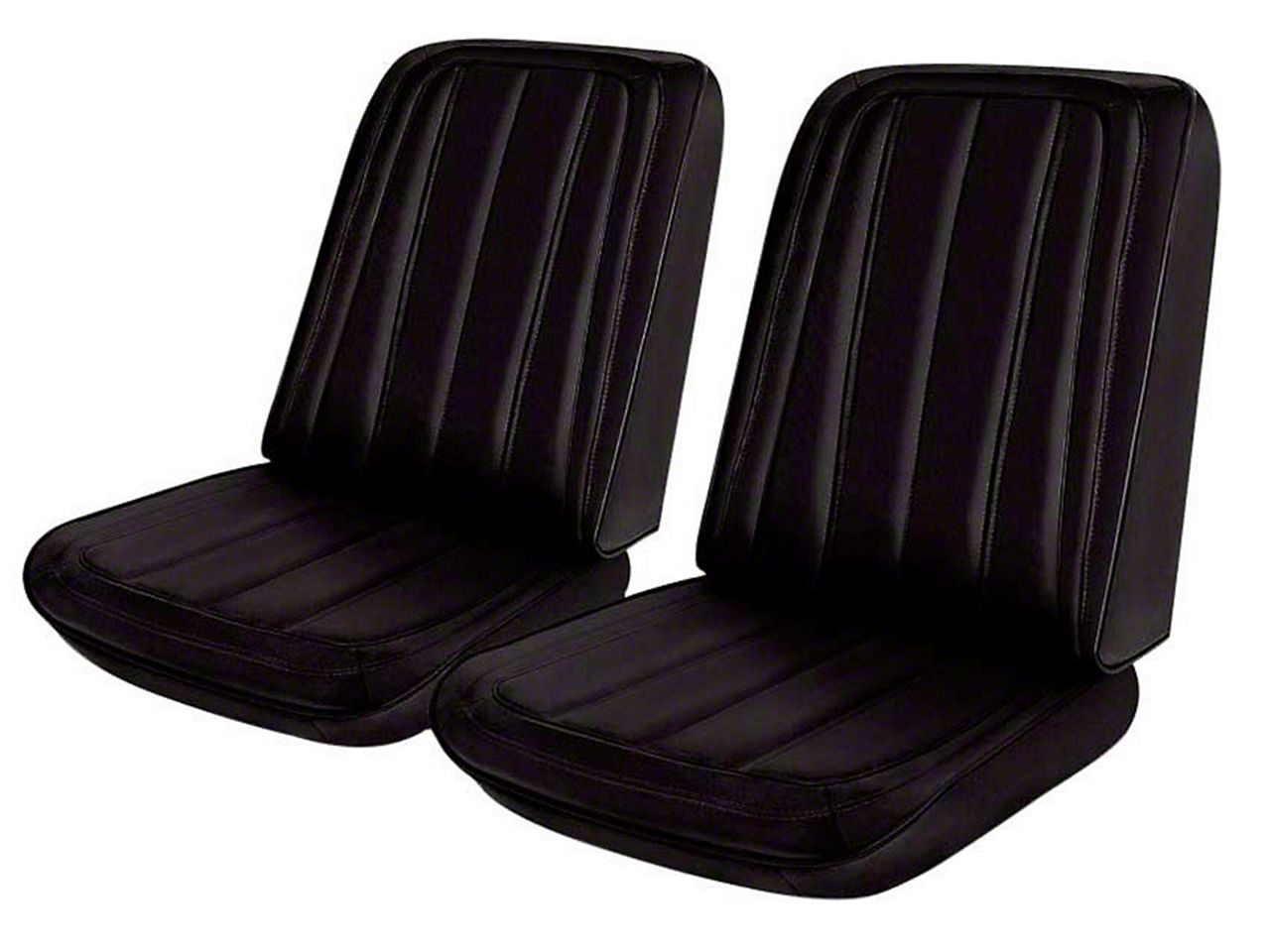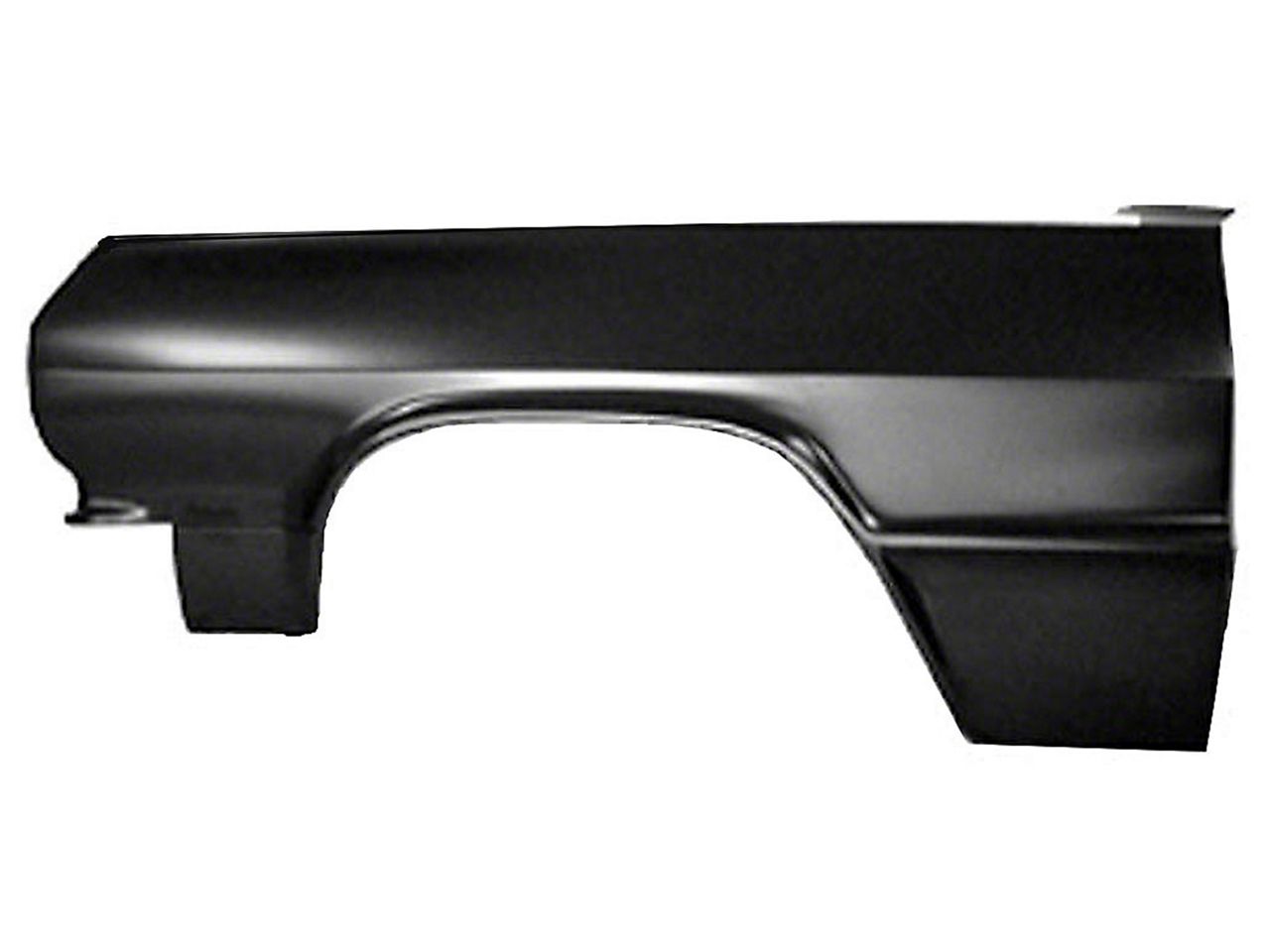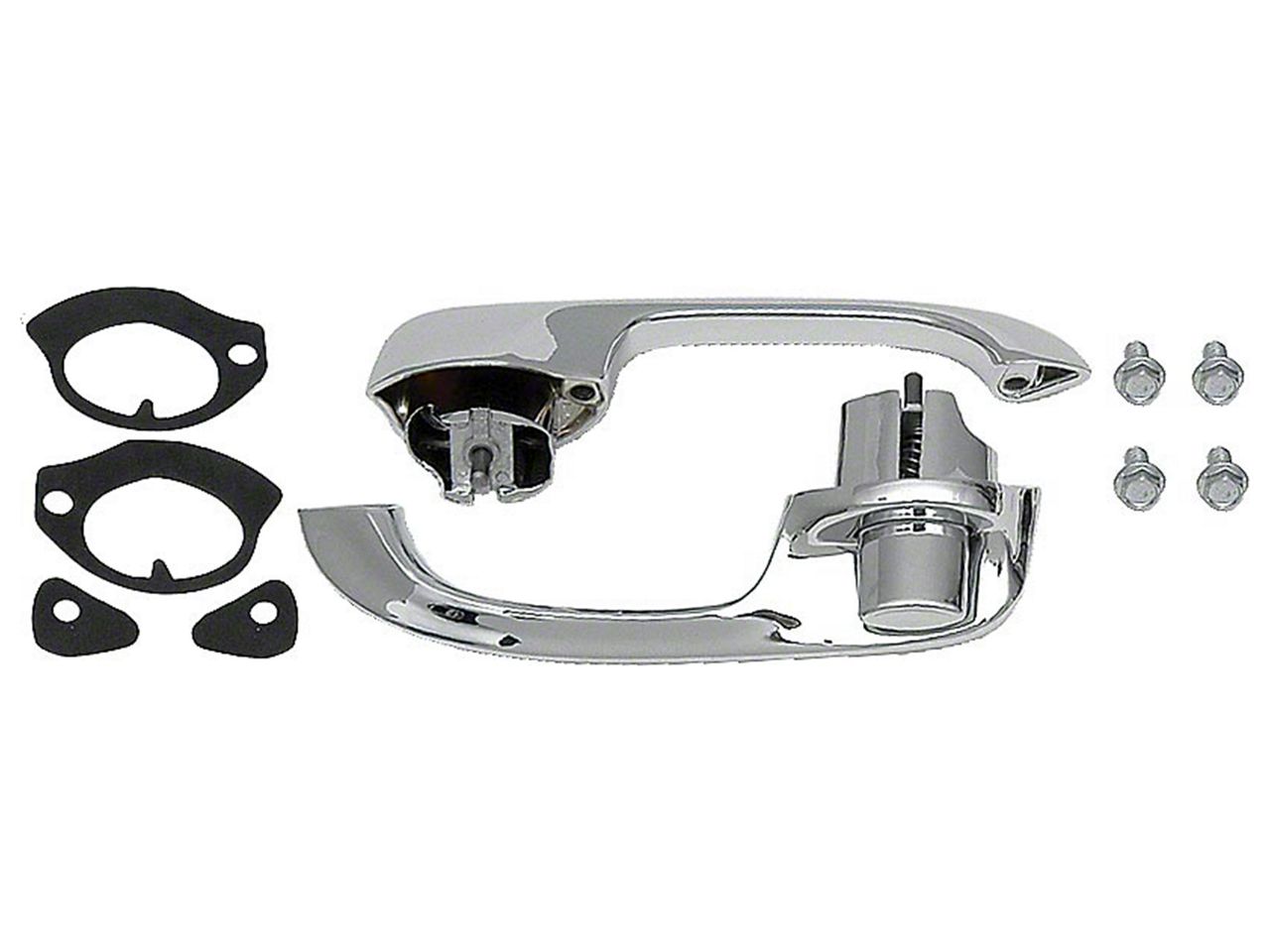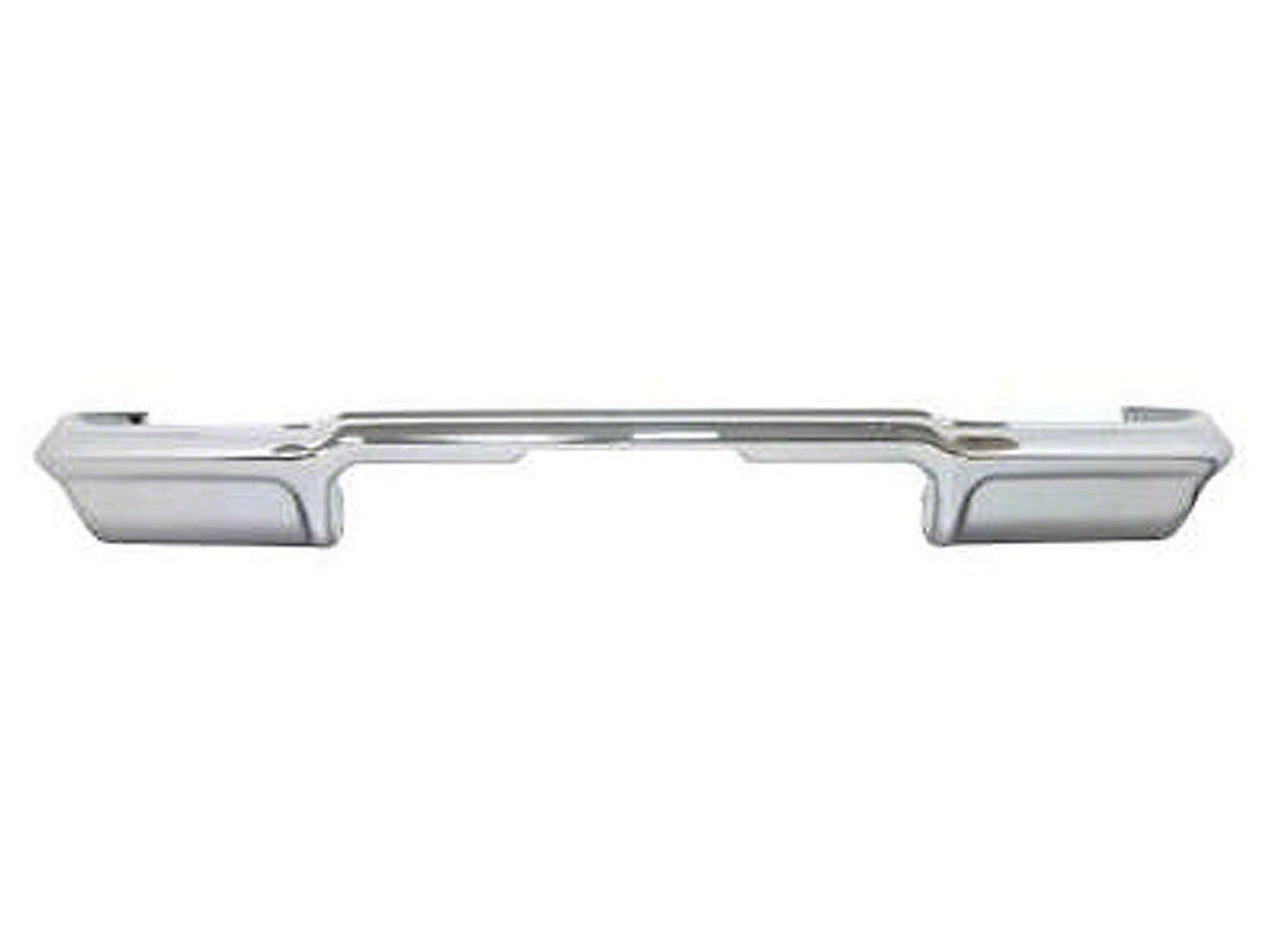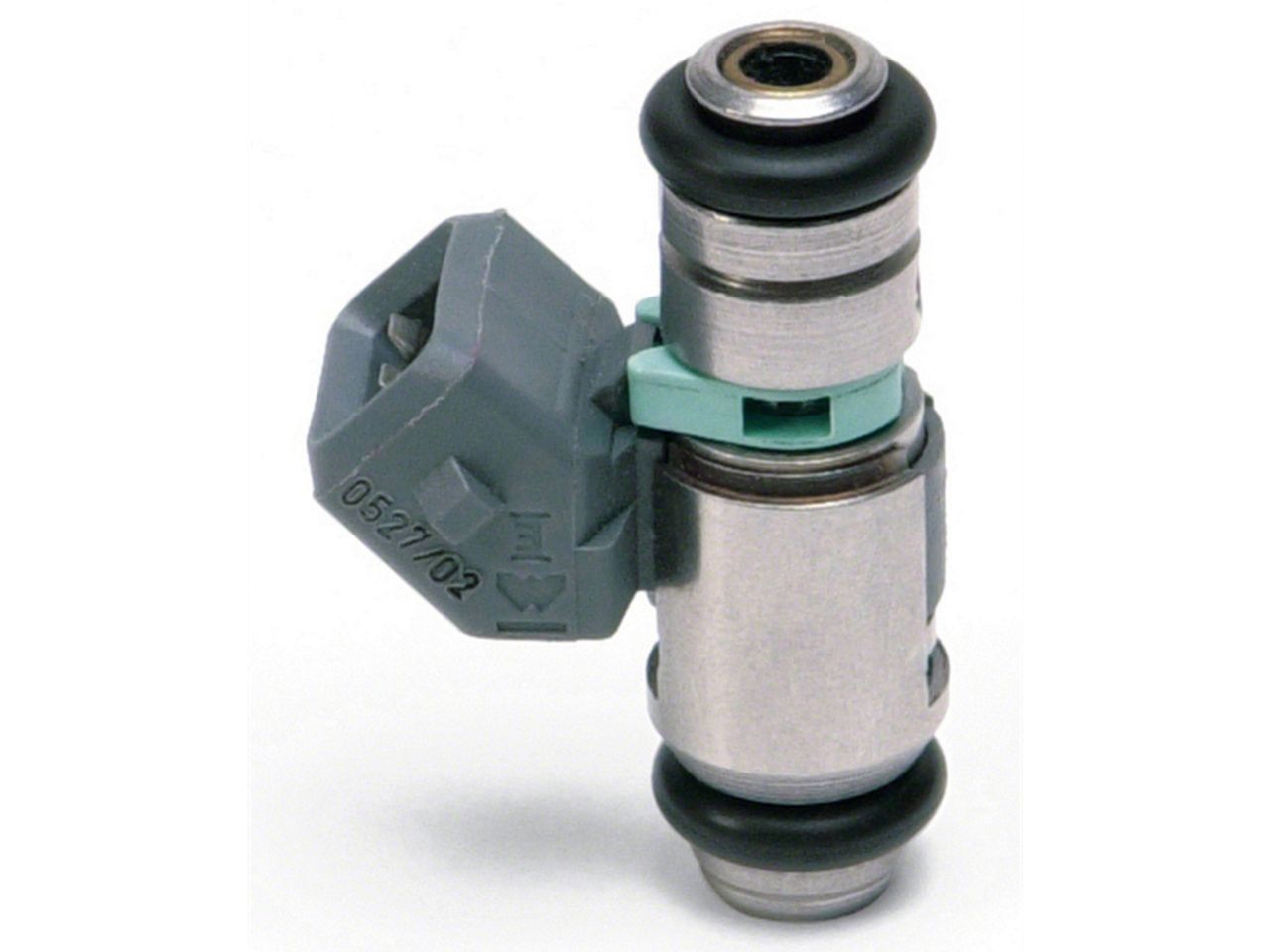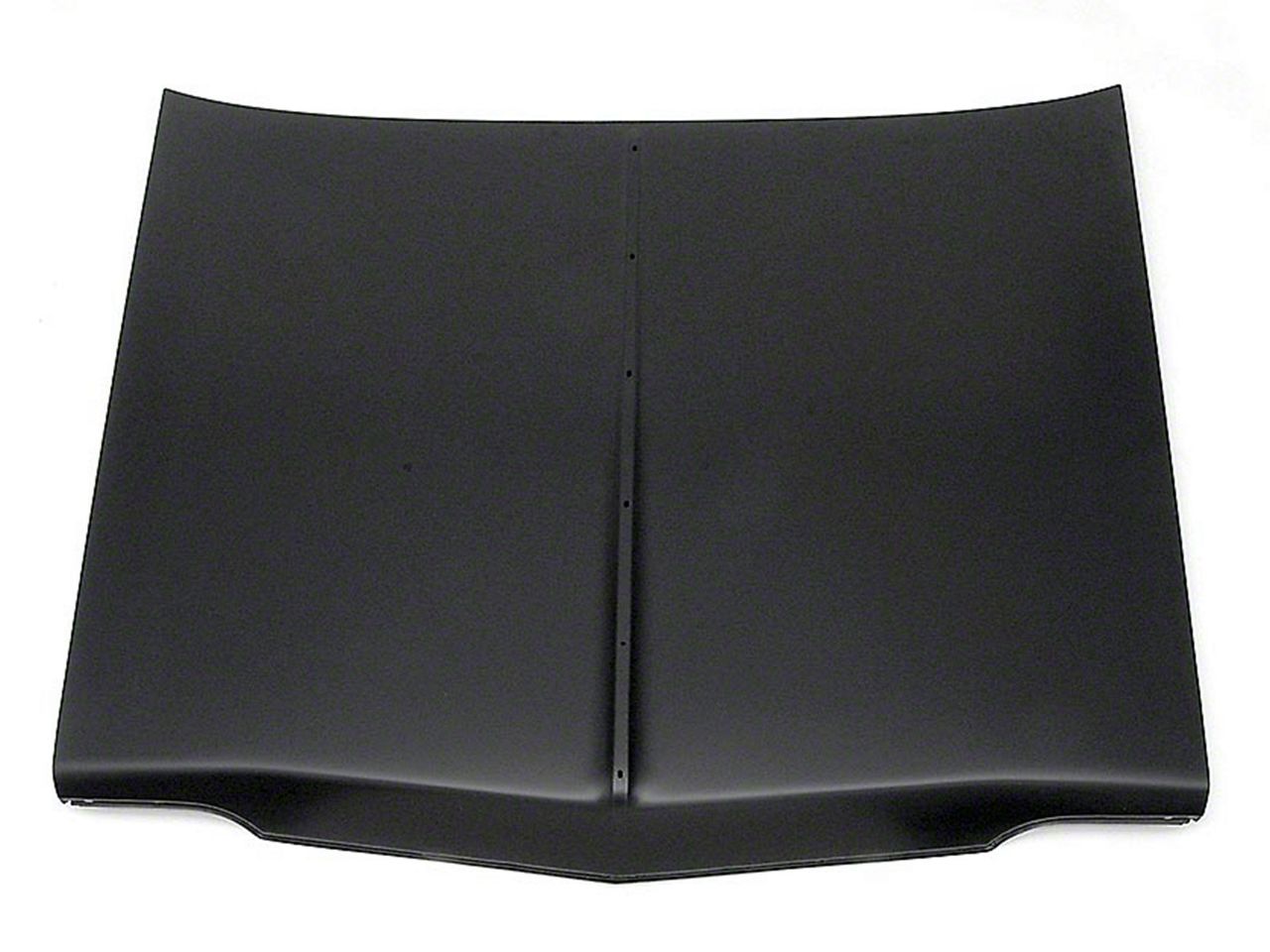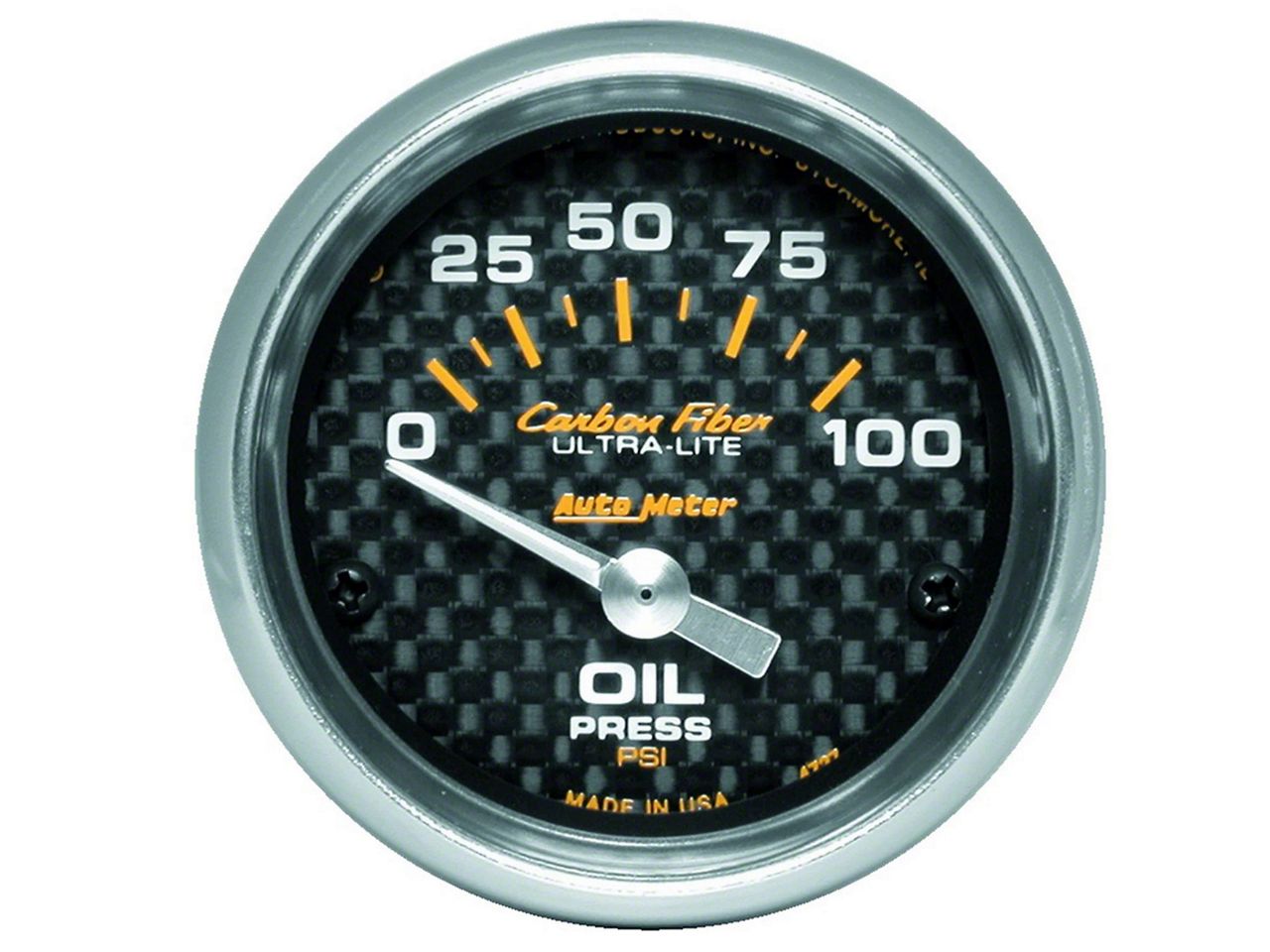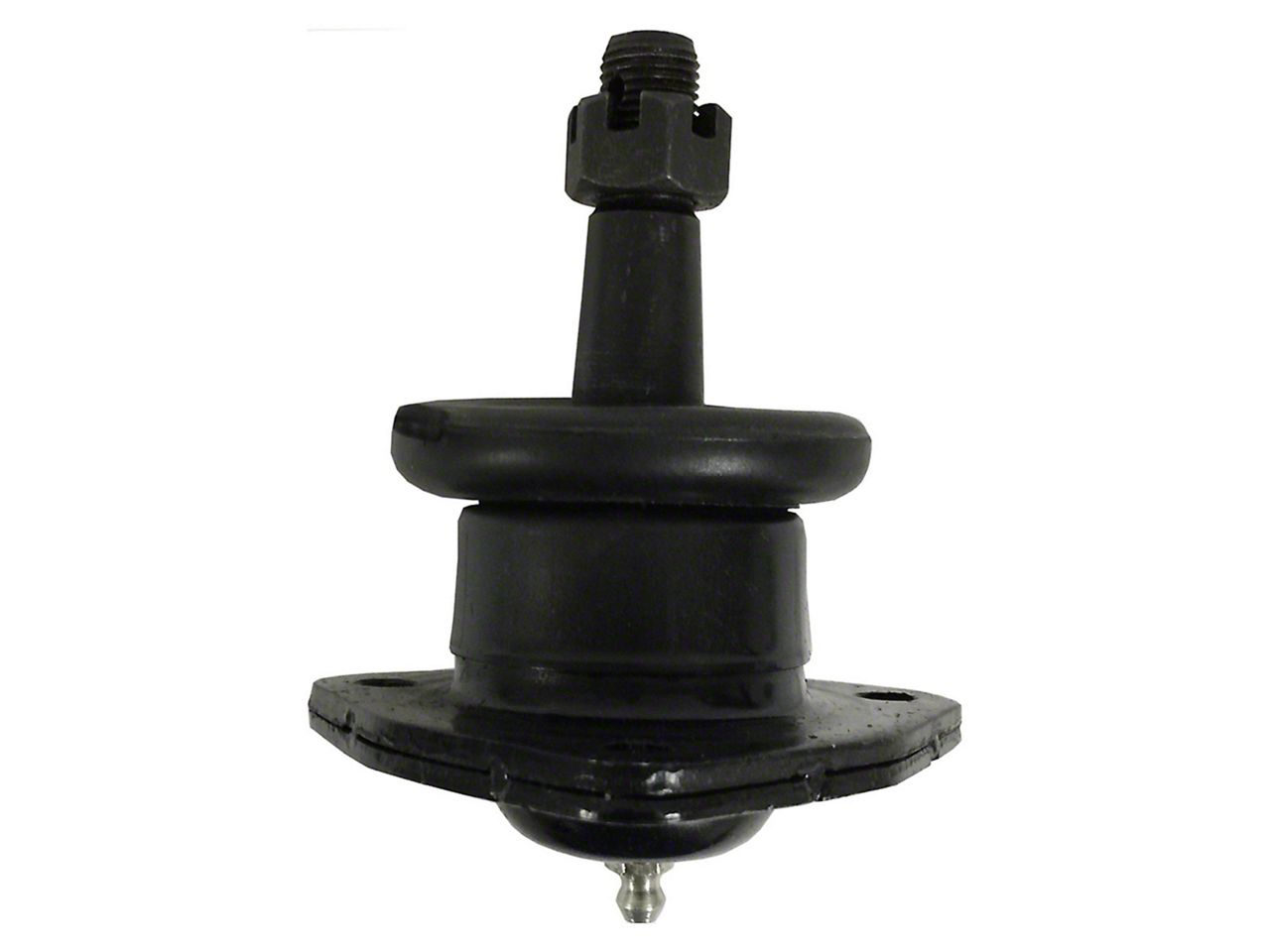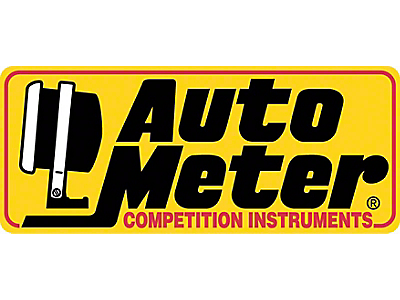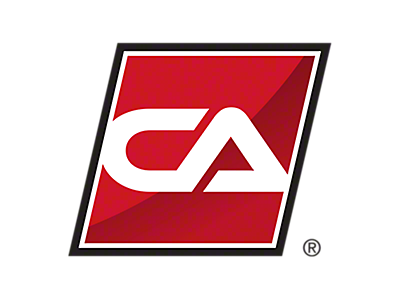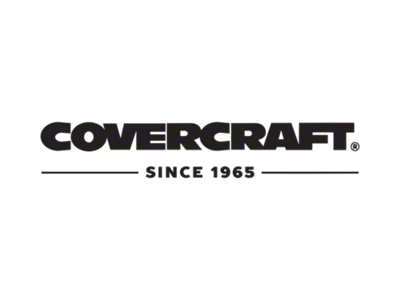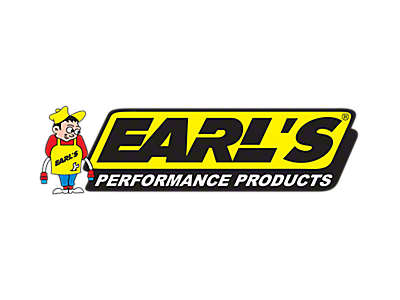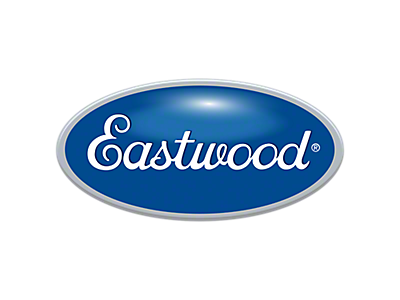"Late Great Chevy Introduced in 1958 and was one of Chevy’s most expensive passenger cars The Chevy Impala was introduced in 1958 and was one of Chevy’s most expensive passenger cars through to 1965. Known as the Bel Air Impala, it had a longer wheelbase and a 2-spoke steering wheel, as well as color-keyed door panels with aluminum trim, sculpted rear end, three tail lights on each side, crossed-flags insignias, dummy rear-fender scoops, bright rocker moldings and dual headlamps. The standard engine was a 283 cu V8, and an optional W block 348 cu Turbo-Thrust V8 was also available, with 250, 280 or 315 horsepower. The 1958 Chevrolet Bel Air had a variety of body styles and numerous options at the time, including the new Safety-Girder cruciform frame, with box-sectioned side rails and a boxed front cross member that went under the engine. 1958 was also the year the 2-door and 4-door Biscayne was introduced, with a focus on attracting buyer who wanted a full-size car without a full-size price. It was also in 1958 that the Chevrolet Delray became its own series. The 1958 Chevy Delray was longer and lower than in previous years, but limited interior and exterior trim and options, as it was positioned at the bottom of the line of the Chevrolet series. Police departments loved the Delray because of the economical attraction of this full-size car. Just about any engine and transmission choice was available to the buy, too. One shouldn’t forget about the Chevrolet Yeoman and the Chevrolet Nomad that was also available during these years. The Nomad name was actually put on the 4-door Bel Air station wagon in 1958. Just like the rest of the 1958 Chevy full-sized cars, the Nomad had the Safety-Girder cruciform frame, box-section side rails, and a boxed front cross member. The Yeoman was an entry-level station wagon available in both 2-door and 4-door design. The Yeoman didn’t have a long production life, unfortunately, being dropped at the end of 1958. In 1959 the Chevrolet Impala got a new look, with a 1 ½ inch longer wheel base, new X-frame chassis, lower roof line, wider body, outward tailfins, and new teardrop shaped taillights. This was the year the Impala would become its own series, with a convertible, 2-door sports coupe, 4-door hardtop and a 4-door sedan. The 1959 Chevy Impala had standard features such as front and back armrests, clock, dual sliding sun visors and front vent windows, as well as new deep-set gauges on a contoured instrument panel. Options included a 6-way power seat function and the Speedminder. As for the 1959 Bel Air new fuel injection, lowered compression and special cams would boost horsepower up to 315 this year. In 1960 the Bel Air’s double cone tail lights would return and the car would see a less dramatic front end design. There was now a Bel Air Sports Coupe. During this 1959 year the Nomad was made part of the Impala model range, and was a 6-passenger car. It would get a new style in 1960. The Impala’s rounded tail lights would return in 1960, with three on each side. There were now seven V8s available in either 383cu or 348 cu. While fuel injection wasn’t available on full-size Chevys any longer, speed control and cruise control were now available as options. The Fleetmaster, a toned down version of the Biscayne, appeared in 1960. Lower-priced and really meant for the fleet market, it didn’t have amenities like door armrest, passenger-side sun visor, cigarette lighter or chrome plated parts, instead going for the more affordable painted parts. The Fleetmaster would only be in production until 1961. The Biscayne would have a full model facelift for 1961, and in 1962 there would be a 5-door station wagon available. It was in 1961 that the Impala was on the GM B platform for the first time. A new bubbleback roof line was introduced this year for the sports coupe models. The rare 2-door pillared sedan came out this year, and the equally rare Super Sport option made an appearance. The 1961 Impala SS package was available on all of the Impalas and included better wheels, springs, sintered metallic brake lining, and shocks. There were only 142 1961 Impala Super Sports with the 490 cu 6.7-liter V8. This special appearance package would be available on the convertible coup and hardtop coupe only starting in 1962. From 1962-63 and in 1968 the SS was known as RPO Z03. The 1962 Chevrolet Impala had a new C pillar style, with the exception of the 4-door hardtop. This was the year of the popular convertible roof style of the Impala Sport Coupe, which was shared with GM B full-sized hardtop coupes. Under the hood was the 380 brake horsepower 409 cu 6.7-liter engine and the 409 cu engine. Both came with a manual shift transmission. The Powerglide would be the only automatic transmission available until 1965 after the discontinuation of the Turboglide automatic transmission. Inside the Impala was all about style with truly plush, comfortable seating and an optional newly designed radio. The chrome trim on the outside was kicked up a notch with a wide panel made of chrome and aluminum, housing the taillight assembly. The Super Sport (SS) had a special engine-turned aluminum panel that filled the side moldings. The sheet metal on the Bel Air would be swapped out in 1962, as the body was lengthened to 209.6 inches. The 4-door sport hardtop Bel Air was no longer available. While the engines for the Bel Air were the same as they were in 1961, now available was a 327 cu V8, a 409 cu V8 with 380 horsepower or 409 horsepower with dual 4-barrel carburetor. 1962 Bel Airs now had carpeting as standard in all models. It was in 1964 that the Chevrolet Impala would get a rounded look, with its recognizable inverted U shaped trim strip above the taillights and body-colored panel. The 1964 Bel Air, however, wouldn’t see very much updating other than standard trim and sheet metal upgrades. The 4-door hardtop Impala Caprice was introduced in 1965, with new upholstery, wood-grain accents and special pulls on the inside of the doors. This was the year of the spinner wheel covers with the Chevrolet bowtie emblem in the center, as well a blackout rear trim strip under the tail lights with a Caprice by Chevrolet badge. The small-block and big-blog V8s were standard, as well as an inline 6-cylinder. The 1965 Chevrolet Impala Caprice had the option of a new three-range Turby Hydra-Matic automatic transmission. The 409 6.7-liter W engine was discontinued this year. In 1966 the new big-block V8s, the RPO L36 and the L72. The L72 would no longer be available in 1967. The I966 Impala SS would get new rectangular taillights and a chrome beltline strip, as well as new high-backed Strato bucket seats and new centre console. The 1965 Bel Air was completely new both inside and out. Now 213.3 inches long, the new grille extended lower on the v-shaped bumper, the window glass was curved and the taillights were now round and mounted higher than before. Inside there was now a new glove compartment light, and a new dash. While the V8 was still the standard 283 CID model, there were now two optional 396 cu CID engines and two 409 CID block engines. The 1966 Bel Air had even more changes to its body, with a new grille and new blunted front fenders, as well as dual rectangular rear lights with built in backup lights. The station wagons had all-vinyl interiors and the sedans had cloth-and-vinyl trims. The 1965 Biscayne now had more engines available, including a 250 ci inline-6. It’s body was bigger while still being an affordable car. The new big block 427 ci V8 would be available for the 1966 Biscayne. The Coke bottle style was big in 1967 and the 1967 Chevy Impala would have curves for days. A new collapsible energy-absorbing steering column, side markers and shoulder seatbelts were introduced to comply with new federal safety regulations. While the L72 was no longer available, a special L35 Turbo-Jet V8 could be special ordered. The 1967 Bel Air now had triple taillights and a bulging rear fender, and the same standard engine as previous year, but this time with optional engines being a 327 CID V8, a 396 CID V8, and a 427 CID V8. In 1968 the 2-door Impala Custom Coupe was introduced. Sales of the Impala SS dropped in 1968. The Super Sport was now an option package for the Impala convertible and the coupes. One of the most collectible cars today is the Impala with a Z24 package, which includes the SS427 emblem, pancake hood, and the three gills on the front fender. The Impala SS was only available as the Z24 (SS427) in 1969, with a 427 cu 7.0-liter V8. There was also the Z03 Impala SS this year, with its Impala Super Sport badge on the front grille, trunk lid and back fenders. The Biscayne station wagon was discontinued in 1968 and then sold as the Brookwood. From this year, 1968 through to 1972 the Nomad name, and the Nomad Custom, would be put on the low priced Chevelle 4-door station wagon. In 1969 the Chevy Impala received new front bumpers and horizontal taillights in the rear bumper, and a relocation of the ignition switch to the steering column. A notchback roofline was now on the hardtop Sport Coupe. It was in 1969 that the Impala station wagons would be known as Kingswood. The 1970 Chevy Impala would have a few upgrades, including new triple vertical taillights in the rear bumper and a new bumper under the grille instead of the wraparound bumper. The Turbo-Jet 454 big block V8 was available. The new B-body in 1971 was Chevrolets biggest car ever. In the meantime, the 1970 Bel Air got a new front end and would only be sold as a 4-door sedan. The Bel Air station wagon would be renamed the Townsman. Power brakes and power steering were now standard for the 1970 Biscayne. The Chevelle Nomad this year would get a new style, with the head lamps in their own chrome housing instead of being part of the grille. The Chevy Impala was discontinued in 1985. Fast forward to 1992 when the Impala SS was reintroduced as a concept car at the Detroit Auto Show. It was in 1994 that the Impala SS would come back to the line. It used the 9C1 police package off the Caprice as its base offering, which included sport-tuned suspension, reinforced springs and shocks, high-capacity reverse-flow cooling system, transmission cooler, dual exhaust and other upgrades. The 1994 Impala SS also had a standard 3.08 gear and a lower suspension, as well as a standard limited-slip rear differential. Under the hood was a standard LT1 5.7-liter 350 cu small-block V8 with 260 horsepower. Visually the 1994 Impala SS had body-colored trim, rear deck spoiler, a new single-bar grille, and 17-inch brushed aluminum wheels. The interior of the Impala now had cup holders, storage compartment, leather seats and a leather wrapped steering wheel. The 1994 Chevy Impala SS was available only with in black, but in 1995 two more colors were available, dark grey green and dark cherry metallic. In 1995 the side mirrors were now located on the A pillar, rather than attached to the door. In 1996 an analog speedometer and tachometer were added to the car and the shifter was moved to the center console. The final 1996 Impala SS was in December, 1996. fun facts: The Beachboys song “409” is about the 1962 Chevrolet Impala. The hit TV show Supernatural features a black 1967 Impala Sports Sedan 4-door hardtop. The Chevy Impala got its name from the African antelope, the Impala. The Chevy Impala was introduced in 1958 The Chevy Impala was introduced in 1958 and was one of Chevy’s most expensive passenger cars through to 1965. Known as the Bel Air Impala, it had a longer wheelbase and a 2-spoke steering wheel, as well as color-keyed door panels with aluminum trim, sculpted rear end, three tail lights on each side, crossed-flags insignias, dummy rear-fender scoops, bright rocker moldings and dual headlamps. The standard engine was a 283 cu V8, and an optional W block 348 cu Turbo-Thrust V8 was also available, with 250, 280 or 315 horsepower. The 1958 Chevrolet Bel Air had a variety of body styles and numerous options at the time, including the new Safety-Girder cruciform frame, with box-sectioned side rails and a boxed front cross member that went under the engine. 1958 was also the year the 2-door and 4-door Biscayne was introduced, with a focus on attracting buyer who wanted a full-size car without a full-size price. It was also in 1958 that the Chevrolet Delray became its own series. The 1958 Chevy Delray was longer and lower than in previous years, but limited interior and exterior trim and options, as it was positioned at the bottom of the line of the Chevrolet series. Police departments loved the Delray because of the economical attraction of this full-size car. Just about any engine and transmission choice was available to the buy, too. One shouldn’t forget about the Chevrolet Yeoman and the Chevrolet Nomad that was also available during these years. The Nomad name was actually put on the 4-door Bel Air station wagon in 1958. Just like the rest of the 1958 Chevy full-sized cars, the Nomad had the Safety-Girder cruciform frame, box-section side rails, and a boxed front cross member. The Yeoman was an entry-level station wagon available in both 2-door and 4-door design. The Yeoman didn’t have a long production life, unfortunately, being dropped at the end of 1958. In 1959 the Chevrolet Impala got a new look, with a 1 ½ inch longer wheel base, new X-frame chassis, lower roof line, wider body, outward tailfins, and new teardrop shaped taillights. This was the year the Impala would become its own series, with a convertible, 2-door sports coupe, 4-door hardtop and a 4-door sedan. The 1959 Chevy Impala had standard features such as front and back armrests, clock, dual sliding sun visors and front vent windows, as well as new deep-set gauges on a contoured instrument panel. Options included a 6-way power seat function and the Speedminder. As for the 1959 Bel Air new fuel injection, lowered compression and special cams would boost horsepower up to 315 this year. In 1960 the Bel Air’s double cone tail lights would return and the car would see a less dramatic front end design. There was now a Bel Air Sports Coupe. During this 1959 year the Nomad was made part of the Impala model range, and was a 6-passenger car. It would get a new style in 1960. The Impala’s rounded tail lights would return in 1960, with three on each side. There were now seven V8s available in either 383cu or 348 cu. While fuel injection wasn’t available on full-size Chevys any longer, speed control and cruise control were now available as options. The Fleetmaster, a toned down version of the Biscayne, appeared in 1960. Lower-priced and really meant for the fleet market, it didn’t have amenities like door armrest, passenger-side sun visor, cigarette lighter or chrome plated parts, instead going for the more affordable painted parts. The Fleetmaster would only be in production until 1961. The Biscayne would have a full model facelift for 1961, and in 1962 there would be a 5-door station wagon available. It was in 1961 that the Impala was on the GM B platform for the first time. A new bubbleback roof line was introduced this year for the sports coupe models. The rare 2-door pillared sedan came out this year, and the equally rare Super Sport option made an appearance. The 1961 Impala SS package was available on all of the Impalas and included better wheels, springs, sintered metallic brake lining, and shocks. There were only 142 1961 Impala Super Sports with the 490 cu 6.7-liter V8. This special appearance package would be available on the convertible coup and hardtop coupe only starting in 1962. From 1962-63 and in 1968 the SS was known as RPO Z03. The 1962 Chevrolet Impala had a new C pillar style, with the exception of the 4-door hardtop. This was the year of the popular convertible roof style of the Impala Sport Coupe, which was shared with GM B full-sized hardtop coupes. Under the hood was the 380 brake horsepower 409 cu 6.7-liter engine and the 409 cu engine. Both came with a manual shift transmission. The Powerglide would be the only automatic transmission available until 1965 after the discontinuation of the Turboglide automatic transmission. Inside the Impala was all about style with truly plush, comfortable seating and an optional newly designed radio. The chrome trim on the outside was kicked up a notch with a wide panel made of chrome and aluminum, housing the taillight assembly. The Super Sport (SS) had a special engine-turned aluminum panel that filled the side moldings. The sheet metal on the Bel Air would be swapped out in 1962, as the body was lengthened to 209.6 inches. The 4-door sport hardtop Bel Air was no longer available. While the engines for the Bel Air were the same as they were in 1961, now available was a 327 cu V8, a 409 cu V8 with 380 horsepower or 409 horsepower with dual 4-barrel carburetor. 1962 Bel Airs now had carpeting as standard in all models. It was in 1964 that the Chevrolet Impala would get a rounded look, with its recognizable inverted U shaped trim strip above the taillights and body-colored panel. The 1964 Bel Air, however, wouldn’t see very much updating other than standard trim and sheet metal upgrades. fun facts: The Beachboys song “409” is about the 1962 Chevrolet Impala. The hit TV show Supernatural features a black 1967 Impala Sports Sedan 4-door hardtop. The Chevy Impala got its name from the African antelope, the Impala. This was the year of the spinner wheel covers The 4-door hardtop Impala Caprice was introduced in 1965, with new upholstery, wood-grain accents and special pulls on the inside of the doors. This was the year of the spinner wheel covers with the Chevrolet bowtie emblem in the center, as well a blackout rear trim strip under the tail lights with a Caprice by Chevrolet badge. The small-block and big-blog V8s were standard, as well as an inline 6-cylinder. The 1965 Chevrolet Impala Caprice had the option of a new three-range Turby Hydra-Matic automatic transmission. The 409 6.7-liter W engine was discontinued this year. In 1966 the new big-block V8s, the RPO L36 and the L72. The L72 would no longer be available in 1967. The I966 Impala SS would get new rectangular taillights and a chrome beltline strip, as well as new high-backed Strato bucket seats and new centre console. The 1965 Bel Air was completely new both inside and out. Now 213.3 inches long, the new grille extended lower on the v-shaped bumper, the window glass was curved and the taillights were now round and mounted higher than before. Inside there was now a new glove compartment light, and a new dash. While the V8 was still the standard 283 CID model, there were now two optional 396 cu CID engines and two 409 CID block engines. The 1966 Bel Air had even more changes to its body, with a new grille and new blunted front fenders, as well as dual rectangular rear lights with built in backup lights. The station wagons had all-vinyl interiors and the sedans had cloth-and-vinyl trims. The 1965 Biscayne now had more engines available, including a 250 ci inline-6. It’s body was bigger while still being an affordable car. The new big block 427 ci V8 would be available for the 1966 Biscayne. The Coke bottle style was big in 1967 and the 1967 Chevy Impala would have curves for days. A new collapsible energy-absorbing steering column, side markers and shoulder seatbelts were introduced to comply with new federal safety regulations. While the L72 was no longer available, a special L35 Turbo-Jet V8 could be special ordered. The 1967 Bel Air now had triple taillights and a bulging rear fender, and the same standard engine as previous year, but this time with optional engines being a 327 CID V8, a 396 CID V8, and a 427 CID V8. In 1968 the 2-door Impala Custom Coupe was introduced. Sales of the Impala SS dropped in 1968. The Super Sport was now an option package for the Impala convertible and the coupes. One of the most collectible cars today is the Impala with a Z24 package, which includes the SS427 emblem, pancake hood, and the three gills on the front fender. The Impala SS was only available as the Z24 (SS427) in 1969, with a 427 cu 7.0-liter V8. There was also the Z03 Impala SS this year, with its Impala Super Sport badge on the front grille, trunk lid and back fenders. The Biscayne station wagon was discontinued in 1968 and then sold as the Brookwood. From this year, 1968 through to 1972 the Nomad name, and the Nomad Custom, would be put on the low priced Chevelle 4-door station wagon. In 1969 the Chevy Impala received new front bumpers and horizontal taillights in the rear bumper, and a relocation of the ignition switch to the steering column. A notchback roofline was now on the hardtop Sport Coupe. It was in 1969 that the Impala station wagons would be known as Kingswood. The 1970 Chevy Impala would have a few upgrades, including new triple vertical taillights in the rear bumper and a new bumper under the grille instead of the wraparound bumper. The Turbo-Jet 454 big block V8 was available. The new B-body in 1971 was Chevrolets biggest car ever. In the meantime, the 1970 Bel Air got a new front end and would only be sold as a 4-door sedan. The Bel Air station wagon would be renamed the Townsman. Power brakes and power steering were now standard for the 1970 Biscayne. The Chevelle Nomad this year would get a new style, with the head lamps in their own chrome housing instead of being part of the grille. fun facts: The Beachboys song “409” is about the 1962 Chevrolet Impala. The hit TV show Supernatural features a black 1967 Impala Sports Sedan 4-door hardtop. The Chevy Impala got its name from the African antelope, the Impala. 1971 was the kick off of the second generation of Chevrolet Caprice It was completely remodeled and featured a 121.5 inch wheelbase, flush exterior door handles, double shell roof, egg-crate grille design with the Caprice emblem, brushed metal trim around the taillights, two-spoke cushioned steering wheel, new instrument panels, cloth and vinyl upholstery, wood grain trim on the dash, door panels and on the steering wheel. The standard engine was a 400ci Turbo Fire V8 designed to run on regular, low-lead, or unleaded gasoline. Optional engines were the 400 ci Turbo Jet V7 with 300hp and the 454 Turbo Jet V8 with 365hp and dual exhaust. While by 1971 the Bel Air and the Biscayne were relegated to the fleet buyers regular car buyers still liked it’s standard offerings, including the two-segmented taillights. The 250ci 6-cylinder engine and 3-speed manual transmission was standard for the Bel Air through to 1973 on the sedans. The 350 V8 and automatic was standard for the wagons. The 1972 Chevy Impala received a new grille that reached to below the bumper, and the engines were now able to run on unleaded gas. Other federal mandates meant the introduction of the new 5mph impact protection shock-absorbing front bumper in 1973. Both the steering wheel and the instrument panels were now color-matched to the interior colors, and the steering wheel saw the Impala center badge replaced with a Chevrolet badge. In addition, the Kingwood station wagon would once again be known as an Impala in 1973. While production of the Biscayne ended in 1972 in the United States, it actually was still manufactured in Canada until 1975 with a 350 cu V8 and TurboHydramatic automatic transmission. In 1975 the Biscayne even got a new dashboard, climate control graphics and radio and a new optional econominder gauge package and intermittent windshield wipers. The 1972 Chevrolet Caprice had a new lower body than the 1971 model. It also had a new grille, new bumper and new triple taillights mounted into the rear bumper. All Caprice models now had a new Astro Ventilation system. Turbo-Hydramatic transmission, variable ratio power steering and power front disc brakes were standard, and options this year included 6-way power seats, 8-track player and air conditioning. A new pillared 4-door sedan was added to the Caprice line. The Caprice was renamed Caprice Classic in 1973. The Kingswood Estate would be called the Caprice Estate. During this year the convertible was moved from the Impala lineup to the Caprice lineup. For 1973 the Caprice would get a new cross-hatch grill, new square tail lights in the bumper, new EGR valves in the engines and lower horsepower ratings. The 400ci 6.6-Litre Turbo-Fire 2-barrel was now 150hp. In 1974 the Caprice received yet another new grille design and the taillights were above the new rear 5mph bumper. The body styles were basically the same for most models, though the 2-door coupes now had thick B-pillars and fixed rear quarter opera windows. There was a new 4-barrel version of the small block 400ci Turbo Fire V8. In 1974 the front end of the Chevrolet Impalas got a new look with new grille and headlight bezels, new header panel and new bumper design. The Spirit of America limited edition Impala was introduced in 1974 as an appearance package on sport coupe models and featured white or blue exterior paint, white vinyl top, white upholstery with blue or red trim, color matched seat belts and floor mats, white wheel covers, sport-style dual remote outside rear view mirrors, vinyl body-side molding insert with red pin-striping. White rally wheels were optional. In 1974 all Bel Air sedans had a 350 2-barrel V8 engine, with a Turbo-Hydramatic transmission as a standard. Station wagons got a 400ci 4-barrel V8 with Turbo-Hydramatic. 1975 was the final year for the Chevrolet Bel Air. The 1975 Chevy Impala, on the other hand, would get new upholstery, dashboard, door panels, climate control graphics and radio. Kilometers were now added to the speedometers which now read up to 100 mph (160 km/h). During this year catalytic converters and a new HEI (High Energy Ignition) system were also brought in. New options for 1975 included an Ecominder gauge package, divided bench seat with passenger-side recliner, and intermittent wipers. The Landau model was introduced , with a vinyl roof, special paint color choices, dual remote outside rear view mirrors, color-keyed wheel covers, pin-striping and a vinyl bodyside molded insert. As for the Chevrolet Caprice, 1975 would be the last year of the Caprice convertible. In fact approximately 8,350 Caprice Classic convertibles were sold in 1975. The Chevrolet Landau model was introduced this year, featuring new paint choices, sport-styled dual remote outside rear-view mirrors, color-keyed wheel covers, vinyl bodyside molding insert, pin striping and a landau vinyl roof. New Fender and dashboard emblems were included. This year, due to the focus on fuel economy, Chevrolet made the 350ci 5.7-Litre small block V8 2-barrel carburetor standard on all Caprice models, except for the station wagons. The new GM High Energy electric ignition was introduced this year and along with new radial tires the bundle was promoted as Chevrolets New Efficiency System. There was also a new Ecominder gauge package and other options such as intermittent windshield wipers and a 50/50 seating option. In 1976 the Landau would remain unchanged. The Caprice Classic had minor changes, including new rectangular headlights, a new grill, and new exterior and interior trim. The engine options were the same, other than a 350 4-barrel that was now available for sedans and coupes everywhere, including California. This was the last year of the hardtop body style and clamshell tailgate design on the station wagon, and the last year of the big blog 454 V8. fun facts: The Beachboys song “409” is about the 1962 Chevrolet Impala. The hit TV show Supernatural features a black 1967 Impala Sports Sedan 4-door hardtop. The Chevy Impala got its name from the African antelope, the Impala. Narrowed even more and made taller once again in 1977 After the downsized design of the 1976 Chevrolet Impala premiered, production of the new shorter, narrower and taller car increased, leading to its number one position in sales that year. Narrowed even more and made taller once again in 1977, Impala/Caprice was named Motor Trend’s car of the year. From 1977 to 1979 the Impala coupe would have a double bent tempered rear window, much like the Monte Carlo Aerocoupe. In 1977 the Chevrolet Impala was shorter and narrower. In fact this new fame was a smaller version of the 1970 frame. Featuring more headroom, more legroom in the back seat and better trunk space, this Impala would boost Chevrolet sales for the year and kick the Impala up to the number one position for sales. The body of the car wasn’t the only thing to shrink, the engine choices did as well. The inline-6 was back but with only 110 horse power. Other optional engines were the 267 cu and the 305 cu V8s. A diesel engine, the 350 cu 5.7-liter V8 was now available. The Chevy Impala was discontinued in 1985. 1977 brought a new smaller, lighter Caprice Classic. While it was smaller, it actually had more headroom and legroom, and even more truck room than it did before. More than $600million was invested in what GM called Project 77 to create the most-changed full-size Chevy ever. The coupe and sedan were shortened by more than 10 inches, the wheelbases were reduced, the width was reduced, the height was increased and truck capacity increased. The 1977 Caprice would now have the same 166-inch wheelbase as the mid-sized Chevelle. The Caprice was now available as either a Sport Coupe or the Landau Coupe, which had a partially covered vinyl roof. The new lighter bodies and smaller engines meant increased fuel economy as well. More than 660,000 full-sized Chevys were produced for 1977, making them the number one selling car in the U.S. More than a million of these smaller Chevys were made by the following year, 1978. It’s interesting to note that while the last Chevrolet Bel Air 2-door sedan was produced in 1969, the Chevrolet Bel Air was still available in Canada through to 1981. In 1977 the Canadian Bel Air was downsized and offered as a 4-door sedan, 2-door coupe and station wagon. Fuel economy was a big focus for the time, so smaller engines with a 250 ci 6-cylinder were used as standard for the sedans. A first since 1973. Other standards included smaller hubcaps, cloth and vinyl upholstery in the sedans, cigarette lighter, ashtray, dome light on the front doors, all-vinyl interior for the wagons, full carpeting, Astro Ventilation, Delco Freedom battery, power front disc brakes, Turbo Hyrdamatic automatic transmission and variable-ratio power steering. The Caprice was renamed Caprice Classic in 1973. The Kingswood Estate would be called the Caprice Estate. During this year the convertible was moved from the Impala lineup to the Caprice lineup. For 1973 the Caprice would get a new cross-hatch grill, new square tail lights in the bumper, new EGR valves in the engines and lower horsepower ratings. The 400ci 6.6-Litre Turbo-Fire 2-barrel was now 150hp. In 1974 the Caprice received yet another new grille design and the taillights were above the new rear 5mph bumper. The body styles were basically the same for most models, though the 2-door coupes now had thick B-pillars and fixed rear quarter opera windows. There was a new 4-barrel version of the small block 400ci Turbo Fire V8. In 1974 the front end of the Chevrolet Impalas got a new look with new grille and headlight bezels, new header panel and new bumper design. The Spirit of America limited edition Impala was introduced in 1974 as an appearance package on sport coupe models and featured white or blue exterior paint, white vinyl top, white upholstery with blue or red trim, color matched seat belts and floor mats, white wheel covers, sport-style dual remote outside rear view mirrors, vinyl body-side molding insert with red pin-striping. White rally wheels were optional. In 1974 all Bel Air sedans had a 350 2-barrel V8 engine, with a Turbo-Hydramatic transmission as a standard. Station wagons got a 400ci 4-barrel V8 with Turbo-Hydramatic. In 1978 the Caprice Classic improved its fuel economy with numerically lower axel ratios, even though the engines offered were the same. The new aluminum intake manifold on the 305 V8 dropped the engines weight by 35 pounds. Options added this year were the sliding steel moonroof and a 40-channel CB radio in the AM/FM radio. It was in 1980 that the Caprice Classic got a new look once again. With the intention of boosting the fuel economy even further, the Caprice got exterior sheet metal, the hood was tapered lower and the trunk was raised. In addition to a new egg crate style grill, the doors and interior were now lighter. Comparing the 1980 models and the 1979 models,"
Eckler's Catalogs Available Now!
Talk to a Sales Tech
1-610-990-4558
M-F 8:30A-11P ET, Sat-Sun 8:30A-9P ET
